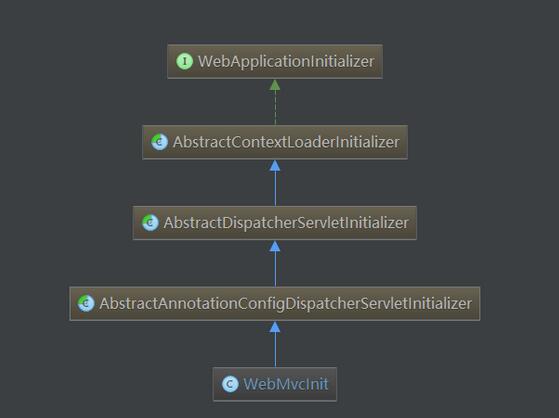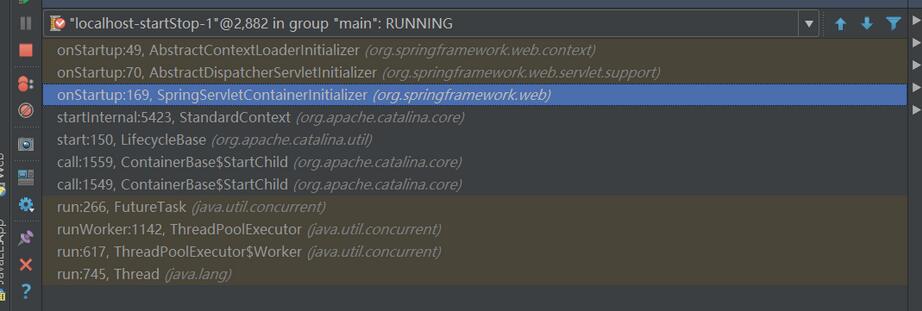详解spring注解配置启动过程
发布于 2017-12-04 22:55:01 | 128 次阅读 | 评论: 0 | 来源: 网友投递
Spring Framework 开源j2ee框架
Spring是什么呢?首先它是一个开源的项目,而且目前非常活跃;它是一个基于IOC和AOP的构架多层j2ee系统的框架,但它不强迫你必须在每一层 中必须使用Spring,因为它模块化的很好,允许你根据自己的需要选择使用它的某一个模块;它实现了很优雅的MVC,对不同的数据访问技术提供了统一的接口,采用IOC使得可以很容易的实现bean的装配,提供了简洁的AOP并据此实现Transcation Managment,等等
这篇文章主要为大家详细介绍了详解spring注解配置启动过程,具有一定的参考价值,感兴趣的小伙伴们可以参考一下
最近看起spring源码,突然想知道没有web.xml的配置,spring是怎么通过一个继承于AbstractAnnotationConfigDispatcherServletInitializer的类来启动自己的。鉴于能力有限以及第一次看源码和发博客,不到之处请望谅~
我用的IDE是IntelliJ IDEA,这个比myEclipse看源码方便一点,而且黑色背景挺喜欢。然后项目是在maven下的tomcat7插件运行。spring版本是4.3.2.RELEASE。
如果写过纯注解配置的spring web,应该知道需要继承一个初始化类来装载bean,然后从这个类开始就会加载我们自定义的功能和bean了,下面是我的一个WebInitializer
@Order(1)
public class WebMvcInit extends AbstractAnnotationConfigDispatcherServletInitializer {
protected Class<?>[] getRootConfigClasses() {
return new Class[]{RootConfig.class,WebSecurityConfig.class};
}
protected Class<?>[] getServletConfigClasses() {
return new Class[]{WebConfig.class};
}
protected String[] getServletMappings() {
return new String[]{"/"};
}
@Override
protected Filter[] getServletFilters() {
return new Filter[]{new HiddenHttpMethodFilter()};
}
}
首先看下AbstractAnnotationConfigDispatcherServletInitializer类的结构,这个也是IDEA的一个uml功能,在类那里右键Diagrams->show Diagrams就有啦

然后我们直接点进AbstractAnnotationConfigDispatcherServletInitializer,可以看到这个类很简单,只有四个方法,然后我们关注下createRootApplicationContext()
@Override
protected WebApplicationContext createRootApplicationContext() {
Class<?>[] configClasses = getRootConfigClasses();
if (!ObjectUtils.isEmpty(configClasses)) {
AnnotationConfigWebApplicationContext rootAppContext = new AnnotationConfigWebApplicationContext();
rootAppContext.register(configClasses);
return rootAppContext;
}
else {
return null;
}
} 这个方法大概意思是获取用户(程序员)传过来的RootClasses,然后注册里面的bean,这些都不是我们关注的,不过这个方法应该是要在启动后执行的,所以我们可以从这个方法往上找
IDEA下Ctrl+G可以找调用某个方法或类,然后设置寻找范围为project and library
我们找到,AbstractContextLoaderInitializer下registerContextLoaderListener(ServletContext servletContext)方法调用子类的createRootApplicationContext()获取WebApplicationContext,继续找registerContextLoaderListener(ServletContext servletContext)方法的调用者,结果发现就是该类下的onStartup(ServletContext servletContext),下面贴下AbstractContextLoaderInitializer类
public abstract class AbstractContextLoaderInitializer implements WebApplicationInitializer {
/** Logger available to subclasses */
protected final Log logger = LogFactory.getLog(getClass());
@Override
public void onStartup(ServletContext servletContext) throws ServletException {
registerContextLoaderListener(servletContext);
}
/**
* Register a {@link ContextLoaderListener} against the given servlet context. The
* {@code ContextLoaderListener} is initialized with the application context returned
* from the {@link #createRootApplicationContext()} template method.
* @param servletContext the servlet context to register the listener against
*/
protected void registerContextLoaderListener(ServletContext servletContext) {
WebApplicationContext rootAppContext = createRootApplicationContext();
if (rootAppContext != null) {
ContextLoaderListener listener = new ContextLoaderListener(rootAppContext);
listener.setContextInitializers(getRootApplicationContextInitializers());
servletContext.addListener(listener);
}
else {
logger.debug("No ContextLoaderListener registered, as " +
"createRootApplicationContext() did not return an application context");
}
}
/**
* Create the "<strong>root</strong>" application context to be provided to the
* {@code ContextLoaderListener}.
* <p>The returned context is delegated to
* {@link ContextLoaderListener#ContextLoaderListener(WebApplicationContext)} and will
* be established as the parent context for any {@code DispatcherServlet} application
* contexts. As such, it typically contains middle-tier services, data sources, etc.
* @return the root application context, or {@code null} if a root context is not
* desired
* @see org.springframework.web.servlet.support.AbstractDispatcherServletInitializer
*/
protected abstract WebApplicationContext createRootApplicationContext();
/**
* Specify application context initializers to be applied to the root application
* context that the {@code ContextLoaderListener} is being created with.
* @since 4.2
* @see #createRootApplicationContext()
* @see ContextLoaderListener#setContextInitializers
*/
protected ApplicationContextInitializer<?>[] getRootApplicationContextInitializers() {
return null;
}
}
注意的是这里我们跳过了AbstractDispatcherServletInitializer抽象类(看uml图),这个类主要配置DispatcherServlet,这里就是spring mvc等功能的实现了。
那谁来加载AbstractContextLoaderInitializer?WebApplicationInitializer已经是接口,不会再有一个抽象类来调用了,于是我尝试性地搜WebApplicationInitializer接口,因为spring这种大项目肯定是面向接口的,所以调用的地方一般是写接口,然后我们找到了SpringServletContainerInitializer类,它实现了ServletContainerInitializer接口,这个类大概是说把所有WebApplicationInitializer都startUp一遍,可以说这个类很接近我们的目标了。下面贴下SpringServletContainerInitializer
@HandlesTypes(WebApplicationInitializer.class)
public class SpringServletContainerInitializer implements ServletContainerInitializer {
@Override
public void onStartup(Set<Class<?>> webAppInitializerClasses, ServletContext servletContext)
throws ServletException {
List<WebApplicationInitializer> initializers = new LinkedList<WebApplicationInitializer>();
if (webAppInitializerClasses != null) {
for (Class<?> waiClass : webAppInitializerClasses) {
// Be defensive: Some servlet containers provide us with invalid classes,
// no matter what @HandlesTypes says...
if (!waiClass.isInterface() && !Modifier.isAbstract(waiClass.getModifiers()) &&
WebApplicationInitializer.class.isAssignableFrom(waiClass)) {
try {
initializers.add((WebApplicationInitializer) waiClass.newInstance());
}
catch (Throwable ex) {
throw new ServletException("Failed to instantiate WebApplicationInitializer class", ex);
}
}
}
}
if (initializers.isEmpty()) {
servletContext.log("No Spring WebApplicationInitializer types detected on classpath");
return;
}
servletContext.log(initializers.size() + " Spring WebApplicationInitializers detected on classpath");
AnnotationAwareOrderComparator.sort(initializers);
for (WebApplicationInitializer initializer : initializers) {
initializer.onStartup(servletContext);
}
}
}
在最后的foreach把所有的WebApplicationInitializer都启动一遍。那么问题来了,谁来启动SpringServletContainerInitializer,spring肯定不能自己就能启动的,在
web环境下,就只有web容器了。我们可以在上面某一个地方打个断点,然后Debug一下(事实上,完全可以全程Debug = =,这样准确又快捷,不过这样少了点寻找的意味,沿路风景还是挺不错的)

可以看到包org.apache.catalina.core下的StandardContext类的startInternal方法,这个已经是tomcat的范围了,所以我们的目标算是达到了。注意的是ServletContainerInitializer接口并不是spring包下的,而是javax.servlet
我猜测,tomcat通过javax.servlet的ServletContainerInitializer接口来找容器下实现这个接口的类,然后调用它们的OnStartUp,然后spring的SpringServletContainerInitializer就可以把所有WebApplicationInitializer都启动一遍,其中就有我们自己写的WebInitializer,另外spring security用注解配置也是实现WebApplicationInitializer启动的,所以这样spring的扩展性很强。这几天再看下tomcat源码,了解下tomcat的机制。
以上就是本文的全部内容,希望对大家的学习有所帮助,也希望大家多多支持PHPERZ。